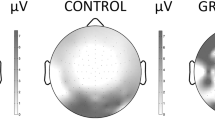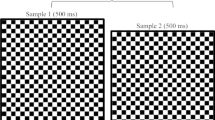Abstract
We designed a study to investigate the patterns of the steady-state visual evoked potential (SSVEP) and auditory steady-state response (ASSR) in adolescents with attention-deficit/hyperactivity disorder (ADHD) when performing a motor response inhibition task. Thirty 12- to 18-year-old adolescents with ADHD and 30 healthy control adolescents underwent an electroencephalogram (EEG) examination during steady-state stimuli when performing a stop-signal task. Then, we calculated the amplitude and phase of the steady-state responses in both visual and auditory modalities. Results showed that adolescents with ADHD had a significantly poorer performance in the stop-signal task during both visual and auditory stimuli. The SSVEP amplitude of the ADHD group was larger than that of the healthy control group in most regions of the brain, whereas the ASSR amplitude of the ADHD group was smaller than that of the healthy control group in some brain regions (e.g., right hemisphere). In conclusion, poorer task performance (especially inattention) and neurophysiological results in ADHD demonstrate a possible impairment in the interconnection of the association cortices in the parietal and temporal lobes and the prefrontal cortex. Also, the motor control problems in ADHD may arise from neural deficits in the frontoparietal and occipitoparietal systems and other brain structures such as cerebellum.



Similar content being viewed by others
References
Fayyad J, De Graaf R, Kessler R, Alonso J, Angermeyer M, Demyttenaere K, De Girolamo G, Haro JM, Karam EG, Lara C (2007) Cross–national prevalence and correlates of adult attention–deficit hyperactivity disorder. Br J Psychiatry 190(5):402–409
Polanczyk G, de Lima MS, Horta BL, Biederman J, Rohde LA (2007) The worldwide prevalence of ADHD: a systematic review and metaregression analysis. Am J Psychiatry 164(6):942–948
Willcutt EG (2012) The prevalence of DSM-IV attention-deficit/hyperactivity disorder: a meta-analytic review. Neurotherapeutics 9(3):490–499
Shahrivar Z, Mahmoodi J, Alavi A, Mohammadi MR, Tehranidoost M, Saadat S (2008) Prevalence of psychiatric disorders amongst adolescents in Tehran. Iran J Psychiatry 3(3):100–104
Association AP (2013) Diagnostic and statistical manual of mental disorders (DSM-5®). American Psychiatric Pub, Washington, DC
Jafari P, Ghanizadeh A, Akhondzadeh S, Mohammadi MR (2011) Health-related quality of life of Iranian children with attention deficit/hyperactivity disorder. Qual Life Res 20(1):31–36
Mohammadi MR, Khaleghi A, Nasrabadi AM, Rafieivand S, Begol M, Zarafshan H (2016) EEG classification of ADHD and normal children using non-linear features and neural network. Biomed Eng Lett 6(2):66–73
Mohammadi MR, Malmir N, Khaleghi A, Aminiorani M (2015) Comparison of sensorimotor rhythm (SMR) and beta training on selective attention and symptoms in children with attention deficit/hyperactivity disorder (ADHD): a trend report. Iran J Psychiatry 10(3):165
Silberstein RB, Farrow M, Levy F, Pipingas A, Hay DA, Jarman FC (1998) Functional brain electrical activity mapping in boys with attention-deficit/hyperactivity disorder. Arch Gen Psychiatry 55(12):1105–1112
Zarafshan H, Khaleghi A, Mohammadi MR, Moeini M, Malmir N (2016) Electroencephalogram complexity analysis in children with attention-deficit/hyperactivity disorder during a visual cognitive task. J Clin Exp Neuropsychol 38(3):361–369
Lei D, Du M, Wu M, Chen T, Huang X, Du X, Bi F, Kemp GJ, Gong Q (2015) Functional MRI reveals different response inhibition between adults and children with ADHD. American Psychological Association, Washington, DC
van Ewijk H, Heslenfeld DJ, Zwiers MP, Buitelaar JK, Oosterlaan J (2012) Diffusion tensor imaging in attention deficit/hyperactivity disorder: a systematic review and meta-analysis. Neurosci Biobehav Rev 36(4):1093–1106
Weyandt L, Swentosky A, Gudmundsdottir BG (2013) Neuroimaging and ADHD: fMRI, PET, DTI findings, and methodological limitations. Dev Neuropsychol 38(4):211–225
Norman LJ, Carlisi C, Lukito S, Hart H, Mataix-Cols D, Radua J, Rubia K (2016) Structural and functional brain abnormalities in attention-deficit/hyperactivity disorder and obsessive-compulsive disorder: a comparative meta-analysis. JAMA Psychiatry 73(8):815–825
Norcia AM, Appelbaum LG, Ales JM, Cottereau BR, Rossion B (2015) The steady-state visual evoked potential in vision research: a review. J Vis 15(6):4–4
Rass O, Krishnan G, Brenner CA, Hetrick WP, Merrill CC, Shekhar A, O’Donnell BF (2010) Auditory steady state response in bipolar disorder: relation to clinical state, cognitive performance, medication status, and substance disorders. Bipolar Disord 12(8):793–803
Silberstein RB, Line P, Pipingas A, Copolov D, Harris P (2000) Steady-state visually evoked potential topography during the continuous performance task in normal controls and schizophrenia. Clin Neurophysiol 111(5):850–857
Silberstein RB, Nunez PL, Pipingas A, Harris P, Danieli F (2001) Steady state visually evoked potential (SSVEP) topography in a graded working memory task. Int J Psychophysiol 42(2):219–232
Line P, Silberstein R, Wright J, Copolov D (1998) Steady state visually evoked potential correlates of auditory hallucinations in schizophrenia. Neuroimage 8(4):370–376
Krishnan GP, Hetrick WP, Brenner C, Shekhar A, Steffen A, O’Donnell BF (2009) Steady state and induced auditory gamma deficits in schizophrenia. Neuroimage 47(4):1711–1719
Krishnan GP, Vohs JL, Hetrick WP, Carroll CA, Shekhar A, Bockbrader MA, O’Donnell BF (2005) Steady state visual evoked potential abnormalities in schizophrenia. Clin Neurophysiol 116(3):614–624
Spencer KM (2011) Baseline gamma power during auditory steady-state stimulation in schizophrenia. Front Human Neurosci 5: 19
Spencer KM, Niznikiewicz MA, Shenton ME, McCarley RW (2008) Sensory-evoked gamma oscillations in chronic schizophrenia. Biol Psychiatry 63(8):744–747
Maharajh K, Abrams D, Rojas D, Teale P, Reite M (2007) Auditory steady state and transient gamma band activity in bipolar disorder. Int Cong Ser 1300: 707–710
Oda Y, Onitsuka T, Tsuchimoto R, Hirano S, Oribe N, Ueno T, Hirano Y, Nakamura I, Miura T, Kanba S (2012) Gamma band neural synchronization deficits for auditory steady state responses in bipolar disorder patients. PloS one 7(7):e39955
Herrmann CS (2001) Human EEG responses to 1–100 Hz flicker: resonance phenomena in visual cortex and their potential correlation to cognitive phenomena. Exp Brain Res 137(3–4):346–353
Wang Y, Wang R, Gao X, Hong B, Gao S (2006) A practical VEP-based brain-computer interface. IEEE Trans Neural Syst Rehabil Eng 14(2):234–240
Thuné H, Recasens M, Uhlhaas PJ (2016) The 40-Hz auditory steady-state response in patients with schizophrenia: a meta-analysis. JAMA Psychiatry 73(11):1145–1153
Staff M (2000) Conners’ continuous performance test II: computer program for windows technical guide and software manual
Kemp AH, Gray MA, Silberstein RB, Armstrong SM, Nathan PJ (2004) Augmentation of serotonin enhances pleasant and suppresses unpleasant cortical electrophysiological responses to visual emotional stimuli in humans. Neuroimage 22(3):1084–1096
Gray M, Kemp A, Silberstein R, Nathan P (2003) Cortical neurophysiology of anticipatory anxiety: an investigation utilizing steady state probe topography (SSPT). Neuroimage 20(2):975–986
Cortese S, Kelly C, Chabernaud C, Proal E, Di Martino A, Milham MP, Castellanos FX (2012) Toward systems neuroscience of ADHD: a meta-analysis of 55 fMRI studies. Am J Psychiatry 169(10):1038–1055
Pei-Chen Chang J, Lane H-Y, Tsai E G (2014) Attention deficit hyperactivity disorder and N-methyl-D-aspartate (NMDA) dysregulation. Curr Pharm Des 20(32):5180–5185
Hamm JP, Gilmore CS, Clementz BA (2012) Augmented gamma band auditory steady-state responses: support for NMDA hypofunction in schizophrenia. Schizophr Res 138(1):1–7
Gonzalez-Burgos G, Lewis DA (2012) NMDA receptor hypofunction, parvalbumin-positive neurons, and cortical gamma oscillations in schizophrenia. Schizophr Bull 38(5):950–957
Edden RA, Crocetti D, Zhu H, Gilbert DL, Mostofsky SH (2012) Reduced GABA concentration in attention-deficit/hyperactivity disorder. Arch General Psychiatry 69(7):750–753
Rubia K, Smith AB, Brammer MJ, Taylor E (2003) Right inferior prefrontal cortex mediates response inhibition while mesial prefrontal cortex is responsible for error detection. Neuroimage 20(1):351–358
Rubia K, Smith A, Brammer M, Toone B, Taylor E (2005) Medication-naïve adolescents with attention-deficit hyperactivity disorder show abnormal brain activation during inhibition and error detection. Am J Psychiatry 162(6):1067–1075
Rubia K, Halari R, Smith AB, Mohammed M, Scott S, Giampietro V, Taylor E, Brammer MJ (2008) Dissociated functional brain abnormalities of inhibition in boys with pure conduct disorder and in boys with pure attention deficit hyperactivity disorder. Am J Psychiatry 165(7):889–897
Pliszka SR, Glahn DC, Semrud-Clikeman M, Franklin C, Perez Iii R, Xiong J, Liotti M (2006) Neuroimaging of inhibitory control areas in children with attention deficit hyperactivity disorder who were treatment naive or in long-term treatment. Am J Psychiatry 163(6):1052–1060
Dickstein SG, Bannon K, Xavier Castellanos F, Milham MP (2006) The neural correlates of attention deficit hyperactivity disorder: An ALE meta-analysis. J Child Psychol Psychiatry 47(10):1051–1062
Smith AB, Taylor E, Brammer M, Toone B, Rubia K (2006) Task-specific hypoactivation in prefrontal and temporoparietal brain regions during motor inhibition and task switching in medication-naive children and adolescents with attention deficit hyperactivity disorder. Am J Psychiatry 163(6):1044–1051
Rubia K, Smith AB, Halari R, Matsukura F, Mohammad M, Taylor E, Brammer MJ (2009) Disorder-specific dissociation of orbitofrontal dysfunction in boys with pure conduct disorder during reward and ventrolateral prefrontal dysfunction in boys with pure ADHD during sustained attention. Am J Psychiatry 166(1):83–94
Rubia K, Halari R, Smith AB, Mohammad M, Scott S, Brammer MJ (2009) Shared and disorder-specific prefrontal abnormalities in boys with pure attention-deficit/hyperactivity disorder compared to boys with pure CD during interference inhibition and attention allocation. J Child Psychol Psychiatry 50(6):669–678
Arnsten AF (2009) Toward a new understanding of attention-deficit hyperactivity disorder pathophysiology. CNS drugs 23(1):33–41
Makris N, Biederman J, Valera EM, Bush G, Kaiser J, Kennedy DN, Caviness VS, Faraone SV, Seidman LJ (2006) Cortical thinning of the attention and executive function networks in adults with attention-deficit/hyperactivity disorder. Cereb Cortex 17(6):1364–1375
Makris N, Buka SL, Biederman J, Papadimitriou GM, Hodge SM, Valera EM, Brown AB, Bush G, Monuteaux MC, Caviness VS (2007) Attention and executive systems abnormalities in adults with childhood ADHD: a DT-MRI study of connections. Cerebral cortex 18(5):1210–1220
Miller BL, Cummings JL (2017) The human frontal lobes: Functions and disorders. Guilford Publications, New York
Szczepanski SM, Knight RT (2014) Insights into human behavior from lesions to the prefrontal cortex. Neuron 83(5):1002–1018
Yuan P, Raz N (2014) Prefrontal cortex and executive functions in healthy adults: a meta-analysis of structural neuroimaging studies. Neurosci Biobehav Rev 42:180–192
Yeo BT, Krienen FM, Eickhoff SB, Yaakub SN, Fox PT, Buckner RL, Asplund CL, Chee MW (2014) Functional specialization and flexibility in human association cortex. Cerebral cortex 25(10):3654–3672
Acknowledgements
The authors wish to acknowledge and appreciate the editorial changes made to the manuscript by Fatemeh Daftari (Department of English, Tehran University).
Funding
This work was supported by the Tehran University of Medical Sciences through a grant from Psychiatry and Psychology Research Center (Grant number 28436).
Author information
Authors and Affiliations
Corresponding author
Ethics declarations
Conflict of interest
No potential conflict of interest was reported by the author(s).
Rights and permissions
About this article
Cite this article
Khaleghi, A., Zarafshan, H. & Mohammadi, M.R. Visual and auditory steady-state responses in attention-deficit/hyperactivity disorder. Eur Arch Psychiatry Clin Neurosci 269, 645–655 (2019). https://doi.org/10.1007/s00406-018-0902-6
Received:
Accepted:
Published:
Issue Date:
DOI: https://doi.org/10.1007/s00406-018-0902-6




